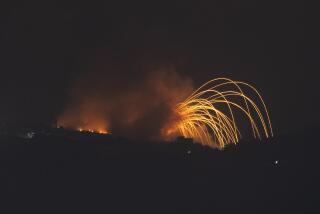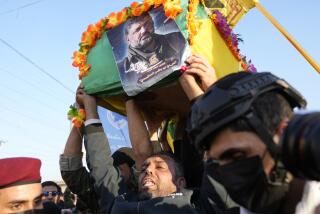Next Step : Iraqi Army Could Put U.S. to Test : The military buildup by Saddam Hussein has been speedy, calculated, impressive--and lethal. It presents a grim prospect in the current gulf crisis.
- Share via
BAGHDAD, Iraq — During the decade before Iraq’s swift, early-morning conquest of Kuwait, the royal family in that tiny Persian Gulf emirate sent hundreds of millions of dollars in military assistance to Iraqi President Saddam Hussein.
Among its gifts: 50 Chieftain-5 main battle tanks that were reportedly part of the Iraqi assault force that invaded and took Kuwait within a matter of hours on Aug. 2.
During those same 10 years, France, which is now part of the multinational force that may soon do battle in the desert, sold Baghdad no less than $5 billion in sophisticated military hardware. Included were 180 Mirage F-1C and state-of-the-art Mirage EQ5 jet fighters, scores of attack helicopters, 200 modern armored personnel carriers, high-tech avionics kits to update outmoded Soviet fighter-bombers, and thousands of anti-tank and anti-ship missiles--all of which would certainly be used against French troops in the event of war.
Also during that same decade, technicians from West Germany--another supporter of the allied effort against Hussein--helped the Iraqi leader develop advanced chemical weapons factories, including one in the Iraqi town of Samarra where Hussein is known to be holding at least eight German hostages as human shields against attack.
Those are among the many ironies in the story of how, within a decade, Iraq quietly managed to build the fourth-largest--and, according to several Western military experts, the third-most sophisticated--armed force on the globe.
It is an $80-billion story of one of the fastest and most calculated military buildups in modern history, and it helps to explain just why U.S. defense officials now say they need at least a month more to assemble an air and ground force of sufficient strength to take on Hussein’s sophisticated, battle-tested military machine on his home desert turf.
Just a few dozen miles from the forward bases of U.S. and allied forces in northern Saudi Arabia are the front lines of an enemy that, in addition to its much-publicized million-member regular army, also possesses: between 4,000 and 4,200 main battle tanks; an additional 5,000 armored personnel vehicles; 9,000 artillery pieces and rocket launchers; hundreds more guided missiles, many with ranges of more than 400 miles, and an air force that includes nearly 1,000 modern warplanes that one Western military expert in Baghdad described as “an airborne fighting force exceeded in sophistication only by the U.S. and the Soviet Union.”
“From the standpoint of equipment,” the expert added, “they are as good as any Western army. They have a mixture of Soviet and Western technology--Soviet for simple weapons systems, and French and other European hardware for the more sophisticated systems.
“And when you look at how the Iraqis went about building up that force, you can only marvel at their ingenuity and commitment. It reads like a textbook of how to create a lethal fighting force that can challenge anyone in their region virtually overnight.”
So great and sophisticated is the firepower of the Iraqis and the growing multinational alliance poised near their border that Dr. Herbert Wulf, an expert at Sweden’s Stockholm International Peace Research Institute recently commented, “It there’s a war, it’s certainly going to be a high-tech war. There will be a lot of casualties on both sides.”
The institute, which closely monitors all arms imports and exports worldwide, prepared a fact sheet within days of Iraq’s invasion that attempts to illustrate both the trend and the scale of Iraq’s arms imports during the decade leading up to the continuing gulf crisis. That, combined with detailed briefings from Western defense analysts in Baghdad and elsewhere, reinforced the grim picture of what is likely to result should the current military and political stalemate in the gulf collapse into all-out war.
“No matter how much equipment and how many men the West and its allies put up against them, the Iraqis certainly are not going to be pushovers,” said one European strategic analyst in Baghdad. “Given the size of the Iraqi air force and the configuration of its air bases, for example, it would take at least a week to 10 days of almost constant fighting before the multinational force could achieve air superiority. What that means is a lot of aircraft and a lot of lives lost--on both sides.”
And, on the ground, Iraq now possesses the modern world’s most successful, desert-proven armored brigades--tank and artillery divisions that won consistent victories over the larger, U.S.-equipped Iranian army during the bloody, eight-year Persian Gulf War.
“When it comes to desert combat, you’re really talking about tank and artillery warfare,” the European expert added. “No doubt that, on paper, the U.S. and British armor is far superior to Iraq’s, which is almost entirely Soviet, but no one knows just how it will perform in an actual war situation. And that’s where Iraq already has proven skills.”
Indeed, Western journalists taken to the Iraqi war front throughout the eight-year conflict consistently saw desert fields pocked with blown-out Iranian tanks and artillery batteries.
It was that same war, however, that led many analysts to question the ability of the true face behind Iraq’s military force--the morale of its fighting men just two years after they gratefully embraced peace for the first time in nearly a decade.
“Morale was good during the last years of the war,” the European analyst said of Iraq’s ground forces. “But after sitting around in camps and not doing much work for quite a long time in remote desert locations, morale got really bad. Many soldiers spent more than a year living in desert tents because the army had to build barracks for them to live in.
“Also, every family had at least one or two prisoners of war in Iran. Now, after Saddam has given away the territory they gained in the Shatt al Arab waterway, many are asking what all these eight years of fighting were for anyway. And lastly, there’s a lot of competition between the regular army and the Republican Guard.”
Variously called the Republican Guard or Presidential Guard, Iraq’s most elite fighting force is actually an army within an army. Fiercely loyal to President Hussein, the guard has a separate chain of command that comes directly under the president and circumvents all other armed service chiefs. The guard gets better pay, better food, better training and better equipment than the regular army, and it consists of no fewer than 10 of the Iraqi army’s 50 operational divisions, or a total of 100,000 men.
It was the Presidential Guard that spearheaded Iraq’s invasion of Kuwait, and, when Baghdad’s control over the emirate was consolidated, the Guard’s divisions were pulled back to strategic rings around Baghdad to defend the Iraqi capital in the event of a future attack from the multinational force.
“There are some jealousies within the regular army, which remains at the front lines in Kuwait,” the European military analyst said. “And morale in general doesn’t seem so good. There are rumors of 120 officers getting shot in the early days of the crisis because they opposed the invasion. The boss of army aviation was changed mysteriously. The chief of the air force hasn’t been seen. He may be in a bunker, but we cannot exclude that he disappeared like so many do here. And there are reports of a half-dozen high ranking officers being jailed because they were questioning the attack on Kuwait.”
Officially, Baghdad denied all the rumors. Iraqi officials insist that morale within its armed force is high, and to reinforce that image state-run Iraqi Television has run almost nightly footage of soldiers smiling, drinking water and preparing for combat at “the front” in Kuwait. Also, despite Iraq’s huge losses during the Iran-Iraq conflict--as many as 500,000 Iraqis dead and 60,000 more taken prisoner--Iraq’s leadership consistently uses the war as a motivator for what may well lie ahead.
In fact, it was the Persian Gulf War that served as the international magnet for Iraq’s massive military buildup. By skillfully casting his nation as the front line of defense against the largely Shiite Islamic fundamentalism of Iran’s Ayatollah Ruhollah Khomeini, Saddam Hussein was showered with billions of dollars in military aid from the West and from virtually every oil-rich, Sunni Muslim-dominated gulf nation--the very same nations that are now opposing him.
“During the decade of the 1980s, Iraq had the highest military expenditure in the Middle East,” declared the Stockholm institute’s fact sheet. “It rose in the early 1980s, reaching a peak in 1984 of $33.3 billion. The military burden or share in (the total economy) was around 30% in that year. After that, military expenditure steadily fell. However, even in 1989, Iraq’s military expenditure was around $15 billion.”
In all, the institute estimates that Iraq may have spent as much as $80 billion on weapons procurement during the decade--higher than that of France, Britain or West Germany during the same time. And the items it purchased from at least 24 nations now read like a shopping list of high-tech destruction--advanced helicopters of every imaginable variety from Chile, Canada, the United States, West Germany, Italy, Spain, France and the Soviet Union; armored cars from Brazil; battle tanks from China and Poland; howitzers from Egypt and Jordan; armored personnel carriers from Libya and Switzerland, and as many as 10,000 guided missiles from virtually every nation that manufactures them.
At the same time, Iraqi scientists hired foreign experts and set to work on a variety of secret weapons projects, chief among them the German-assisted chemical weapons program, a ballistic missile development plan aided by Brazil and several other nations, and the nuclear-weapons project interrupted by Israel’s 1981 air strike on Iraq’s only reactor capable of producing weapons-grade plutonium.
“The Iraqis have shown one extraordinary talent in the military field,” a Western analyst said. “They get all the help from the outside, and they coordinate it and put it together into something better than anything they got in the first place.”
The brains behind that operational strategy, according to many diplomats in Baghdad, is one of the president’s closest and most-trusted relatives, his son-in-law and minister of military industry, Kanil Hussein.
In explaining Kanil Hussein’s power base, a European diplomat said, “First of all, he’s a son-in-law. He’s also very well-educated. He’s not the highest military rank--he’s a captain--but he’s a member of the trusted inner circle, and he’s the boss of the organization that makes the whole military machine run.”
It is largely because of Saddam Hussein’s ruthless yet effective one-man rule, even within his own inner circle, that so many military experts here are highly skeptical that a military coup could be successful in toppling Iraq’s leader.
“There have been coup attempts,” one said. “There might even have been two or three attempts just since the start of the crisis. There were, for example, confirmed reports that there was shooting at the president soon after the invasion. But whatever it was obviously didn’t succeed.
“The problem facing a coup plotter in Iraq is that Saddam has insulated himself not only inside his elite Presidential Guard, but also within no less than five other national security organizations, some civilian and some military,” the expert added. “And even if you could penetrate that, there’s Saddam himself. Never forget that, even as a child, the president was a tough revolutionary fighter and an assassin.
“In many ways, you can say that Saddam Hussein has created this huge and powerful Iraqi armed force in his own personal image.”
More to Read
Sign up for Essential California
The most important California stories and recommendations in your inbox every morning.
You may occasionally receive promotional content from the Los Angeles Times.













